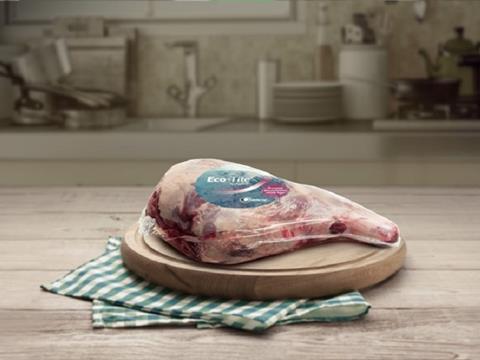
The next of our Sustainability Awards 2021 finalist interviews puts the spotlight on Amcor's Eco-Tite® R PVdC-free shrink bag, which has been nominated in our Pre-commercialized Innovation category.
Congratulations on being selected by the international judging panel as a Sustainability Awards 2020 finalist! Could you please introduce your successful entry and what’s innovative about it?
Eco-Tite® R is the first designed to be recycled, PVdC-free shrink bag for fresh and processed meat, poultry and some cheeses. Amcor Eco-Tite® R is designed to maximize shelf-life, maintain food safety, reduce food waste and can be recycled in existing polyethylene (PE) plastic recycling streams. This means that more consumers will be able to recycle their meat, poultry and cheese packaging, while enjoying the benefits of longer lasting food. Amcor Eco-Tite® R is a multi-layer, mono-PE packaging which maintains a high barrier to oxygen and water vapour even when exposed to high-moisture environments, such as cooler cases and refrigerators. This solution provides European meat and cheese producers an alternative to PVdC (Polyvinylidene Chloride) packaging – which is not recyclable in mechanical or chemical recycling systems.
Historically in shrink packaging, PVdC has been the primary material used for the oxygen barrier – which is essential to keeping the product safe and fresh. Fresh meat is packed in wet and humid environments. It is therefore paramount for meat packaging to maintain its barrier properties when exposed to high-moisture environments.
Eco-Tite® R is different because it utilizes a non-PVdC oxygen barrier and is built primarily on high quality polyethylene. This structure has allowed us to create a recyclable solution that can help manufacturers overcome the challenges of shrink bags not being recyclable ready. To validate recyclability in real-world conditions, Amcor Eco-Tite® R has been certified by the cyclos-HTP institute, an independent testing lab. Consumers can today recycle the bag where suitable infrastructure is in place, including Germany, France, Italy, The Netherlands, Norway, Austria and Spain. Recyclability of the new shrink bag will grow as infrastructure develops in additional
What are the environmental challenges in packaging that your entry addresses, and what impact do you hope it will make?
Eco-Tite ®R is a great step forward for consumers and an example of how the removal of problematic materials from packaging – something the industry is increasingly focused on delivering – can provide us with safe, secure and recyclable packaging. Eco-Tite® R, PVdC-free recyclable shrink bag, maintains product freshness and extend shelf life. Shelf life extension and food waste reduction are possible thanks to the high oxygen and moisture barrier. As certified by the cyclos-HTP institute, Eco-Tite® R is recyclable in the polyethylene stream in countries where collection and recycling streams exist, including Germany, France, Italy, The Netherlands, Norway, Austria and Spain.
The pack proved up to 58% carbon footprint reduction versus standard shrink bags.* It also allows a 49% energy reduction and 45% savings in water consumption which are the equivalent of savings 967 lightbulbs burning for one year and 4090 showers. The assessment was run in ASSET, Amcor's life cycle assessment system certified by the Carbon Trust. This innovation also supports Amcor’s broader commitment to develop all its packaging to be recyclable or reusable by 2025, which it committed to in 2018 as part of its pledge.
Also as member of the CGF Plastic Waste Coalition of Action, Amcor has aligned on Golden Design Rules for packaging design to increase the circularity of their packaging portfolios where appropriate. And the second golden rule is about Removing Problematic Elements from Packaging. PVC and PVDC can be problematic if in the recycling stream by disrupting the recycling of some other plastics.
I’d like to ask you about the broader picture beyond your successful entry. ‘Sustainability’ in packaging is multi-dimensional – both in terms of objectives and challenges. Could you comment on the most important roadblocks you identify from your position in the value chain, and the kinds of solutions you would like to see addressing them (e.g. areas of technological innovation, collaboration, regulation)?
In 2018, Amcor was the first packaging company worldwide to pledge to design all of our packaging to be recyclable or reusable by 2025, and we’ve learned a lot in the last four years while working towards that goal.
Delivering on our pledge, so that all of our packaging is recyclable or reusable by 2025 will be a major step to delivering a more circular system for plastics.
How are we achieving this goal? We’ve deployed our world-class research and development (R&D) experts to focus their efforts on our product portfolio and deliver packaging that is recyclable or reusable as fast as possible.
This is no small challenge; our customers require thousands of technically sophisticated products with highly demanding features and we operate in more than 40 countries.
For technically challenging products, where solutions do not already exist that combine product performance with recyclability, we have assembled groups of engineers in innovation streams to seek scalable solutions. This allows us to enhance collaboration and to deliver ground-breaking expertise and winning outcomes for all our stakeholders.
However, to create a circular system you need two other parts of the puzzle: recycling infrastructure which enables products to be recycled at scale globally; and informed consumers to increase participation in recycling and reuse.
Packaging provides substantial benefits to society and will always have a role to play in delivering the products consumers need. Through better design, and the drive of our people, we’re helping create a more sustainable future. We are also making great progress – by weight, 61% of our Flexible packaging, over 95% of our Rigid packaging and 100% of our Specialty Cartons portfolio is recyclable – but we know we’re not done. In the four years to come, we’re more determined than ever to break through and meet our aspiration that all of our products will be recyclable or reusable by 2025.




















